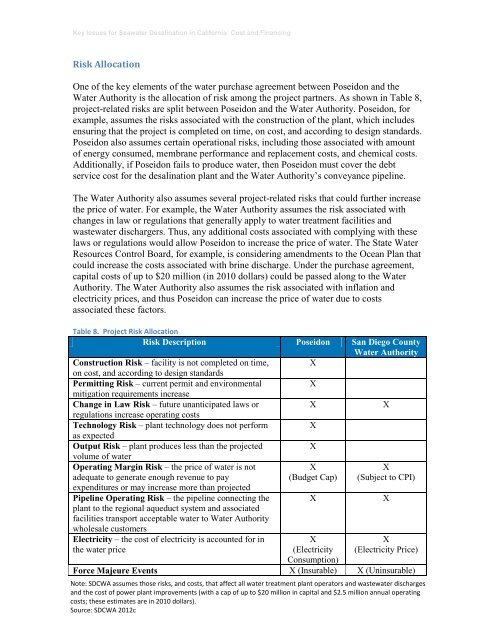997.4 KB - San Francisco Bay Area Independent Media Center
997.4 KB - San Francisco Bay Area Independent Media Center
997.4 KB - San Francisco Bay Area Independent Media Center
You also want an ePaper? Increase the reach of your titles
YUMPU automatically turns print PDFs into web optimized ePapers that Google loves.
Key Issues for Seawater Desalination in California: Cost and Financing<br />
Risk Allocation<br />
One of the key elements of the water purchase agreement between Poseidon and the<br />
Water Authority is the allocation of risk among the project partners. As shown in Table 8,<br />
project-related risks are split between Poseidon and the Water Authority. Poseidon, for<br />
example, assumes the risks associated with the construction of the plant, which includes<br />
ensuring that the project is completed on time, on cost, and according to design standards.<br />
Poseidon also assumes certain operational risks, including those associated with amount<br />
of energy consumed, membrane performance and replacement costs, and chemical costs.<br />
Additionally, if Poseidon fails to produce water, then Poseidon must cover the debt<br />
service cost for the desalination plant and the Water Authority’s conveyance pipeline.<br />
The Water Authority also assumes several project-related risks that could further increase<br />
the price of water. For example, the Water Authority assumes the risk associated with<br />
changes in law or regulations that generally apply to water treatment facilities and<br />
wastewater dischargers. Thus, any additional costs associated with complying with these<br />
laws or regulations would allow Poseidon to increase the price of water. The State Water<br />
Resources Control Board, for example, is considering amendments to the Ocean Plan that<br />
could increase the costs associated with brine discharge. Under the purchase agreement,<br />
capital costs of up to $20 million (in 2010 dollars) could be passed along to the Water<br />
Authority. The Water Authority also assumes the risk associated with inflation and<br />
electricity prices, and thus Poseidon can increase the price of water due to costs<br />
associated these factors.<br />
Table 8. Project Risk Allocation<br />
Risk Description Poseidon <strong>San</strong> Diego County<br />
Water Authority<br />
Construction Risk – facility is not completed on time, X<br />
on cost, and according to design standards<br />
Permitting Risk – current permit and environmental<br />
X<br />
mitigation requirements increase<br />
Change in Law Risk – future unanticipated laws or<br />
X<br />
X<br />
regulations increase operating costs<br />
Technology Risk – plant technology does not perform X<br />
as expected<br />
Output Risk – plant produces less than the projected<br />
X<br />
volume of water<br />
Operating Margin Risk – the price of water is not<br />
adequate to generate enough revenue to pay<br />
expenditures or may increase more than projected<br />
Pipeline Operating Risk – the pipeline connecting the<br />
plant to the regional aqueduct system and associated<br />
facilities transport acceptable water to Water Authority<br />
wholesale customers<br />
Electricity – the cost of electricity is accounted for in<br />
the water price<br />
X<br />
(Budget Cap)<br />
X<br />
X<br />
(Electricity<br />
Consumption)<br />
X<br />
(Subject to CPI)<br />
X<br />
X<br />
(Electricity Price)<br />
Force Majeure Events X (Insurable) X (Uninsurable)<br />
Note: SDCWA assumes those risks, and costs, that affect all water treatment plant operators and wastewater discharges<br />
and the cost of power plant improvements (with a cap of up 38 to $20 million in capital and $2.5 million annual operating<br />
costs; these estimates are in 2010 dollars).<br />
Source: SDCWA 2012c
















